
|
|
Abstract: An early academic overview of Bábí and Bahá'í history and theology. From translation of a 1910 book Vorlesungen uber den Islam, "Lectures on Islam." Notes: This document is online in a variety of formats at archive.org. |
Introduction to Islamic Theology and Law
by Ignaz Goldziher
pages 245-253Princeton University Press, 1981
date of original: 1910
1. Text
10. The movement born in the Arabian Peninsula, whose ideas and effects we have just described, fixed its gaze on the past, denied the legitimacy of the results and achievements of historical development, and insisted that true Islam must have the form of a fossil from the seventh century. But another Islamic movement of recent origin had its point of departure in, and has been animated by, a belief in the religious evolution of mankind This is the Babi movement that arose in Persia.[1]It undoubtedly sprang from the form of Shi'ism prevalent in that country, but its fundamental ideas are related in their development to the principle we have encountered as the guiding thought of the Isma'ili sect: that the divine revelation renders itself more and more perfect through the gradual manifestation of the Universal Intellect.
At the beginning of the nineteenth century the doctrine of the imamate in the Twelver Shia put forth a new branch: the school of the Shaykhis, whose followers practice a fervent cult of the "Hidden Mahdi" and of the Imams who preceded him. In Gnostic fashion, they regard these persons as hypostases of divine attributes, and creative forces. In so doing, they expand the scope of the Imam-mythology of the standard Imamiya, and follow in the footsteps of the "extremists" (ghulat, Ch. V, Sec. 8).
Such was the milieu in which Mirza Muhammad 'All grew up, a young religious enthusiast born in Shiraz in 1820. Because of his zeal and outstanding abilities, his companions recognized him as destined for a sublime calling. Such recognition by his fellow enthusiasts exercised a powerful suggestion upon the mind of the meditative young man. At length he came to regard himself as the embodiment of an exalted, superhuman mission that formed part of the evolution of Islam, and would reveal the role that Islam is to play in the history of the world. From the conviction that he was the Bab, "gate," through which the unerring will of the Hidden Imam, the highest source of all truth, manifested itself to the world, he soon advanced to the belief that he was, in the economy of the evolution of the spirit, something more than the mouthpiece of the Imam of the age living and teaching in occultation. He was himself the new Mahdí making himself known at the precise turn of the millennium following the appearance of the twelfth Imam (a.h. 260-1260). But he no longer conceived of the office of Mahdí as the standard Shi'a did. Rather, he thought of the Mahdi — and here he crossed over to Isma'íli ground — as a manifestation of the World Spirit, as the "point of manifestation," as the highest truth, which had taken corporeal form in him. The Mahdí was different only in appearance from the previous manifestations of the spiritual substance radiating from God, and was identical with them in essence. He was Moses and Jesus reappearing on earth, as well as the reincarnation of all other prophets in whose bodily form, in previous ages of the world, the divine world spirit had manifested itself. To his followers he preached aversion to the mollahs — in Persia particularly, this term is used for the `ulama' — to their sanctimoniousness and hypocrisy, to their worldly aspirations. He sought to raise the revelations of Muhammad, most of which he interpreted in an allegorical manner, to a higher degree of maturity. The practices of Islam, the punctilious laws of ritual purity and the like, were little esteemed in his teaching, and were in part supplanted by others. To Last Judgment, Paradise, Hell, and Resurrection new meanings were assigned.[21] In this he had predecessors in previous spiritualist systems. Resurrection is each new periodic manifestation of the divine spirit, in relation to an earlier one. The first one is raised to a new life by the next. This is the meaning of the phrase "meeting God" that the Qur'an uses to refer to the afterlife.
But it was not only in his dogmatic and legal ideas that the young Persian enthusiast set himself against the ossified theology of the mollahs. His message was also profoundly concerned with the social conditions of his coreligionists. His thoughtful ethics demanded, in place of the walls dividing classes and religions, the brotherhood of mankind. He wished to grant full equality to women, and so to raise them from the low position in which, in the name of tradition, they had in practice been placed. He began by abolishing the obligatory veil, and rejected the crude conception of marriage that had come to prevail, although by no means as a necessary consequence of religious principles, in Islamic society. He advanced a nobler conception of marriage, along with ideas about the tasks of the family and educational reform.
Thus the Bab's intended religious reforms touched the foundations of social life. He was not only a religious, but also a social reformer. But the gnostic and mystical ideas he had begun with remained a pervasive element of the system that he constructed from his views. He combined ideas of modern enlightenment with Pythagorean ingenuities. Like the yurufis (Ch. V, Sec. 18), he played with combinations of letters and ascribed great significance to the numerical values of the letters of the alphabet. The number nineteen has the highest importance in his construction of ideas, and serves as the focus of the exercises in numerology that play a prominent role in his speculations.
Just as he advanced the idea of his own essential identity with the prophets of previous ages[22] — an idea rooted in Gnosticism and also put forward by previous schismatic movements in Islam — so he proclaimed that the divine spirit, embodied in him in his lifetime, would continue in the future to manifest itself again and again. Revelation did not reach its definitive conclusion either in Muhammad or in the Bab himself. In an endless unfolding, the divine spirit makes itself known in periodically renewed manifestations. In these, the divine will appears in ever greater perfection and fullness, in keeping with the progress of history. By advancing such ideas, Mirza Muhammad 'All also prepared the change that was to occur in his community soon after his death.
He set down the sum of his doctrines in a religious book entitled Bay an (Explanation). His sect regards it as holy. These doctrines must have struck the ruling authorities as extremely dangerous, from both the religious and political points of view. Founder and followers who had gathered around him — among whom a woman, the heroic Qurrat ul Ayn ("Solace of the Eye") attracts our sympathy — were mercilessly persecuted and proscribed, hunted down and delivered to the executioner. Muhammad 'All was himself executed in July 1850. The disciples who were spared martyrdom, and whose fervor was only intensified by the persecution they had endured, found refuge on Turkish soil.
Soon after the founder's death, a cleavage occurred in the community of the Bab's believers. He had appointed two disciples to guide the community, and some believers recognized one, some the other, as the more faithful interpreter of the Bab's will. The smaller faction gathered around Subh-i Azal ("Dawn of Eternity"), who resided in Famagusta, in Cyprus. This man wanted to maintain the work of the Bab in the form that the master had given it; his followers are the conservative Babis. The majority of the believers adopted the view of the other apostle, Baha' Allah ("Splendor of God") who, at the beginning of the sixties, during the Babi exiles' stay in Adrianople (Edirne), declared — somewhat beforehand with the cyclical system — that he was the more perfect manifestation prophesied by the master, the one that would raise the Bab's own work to a higher state. Muhammad 'All was his precursor, his John the Baptist, so to speak. In Baha' Allah himself the divine spirit reappeared, to accomplish truly what his precursor's work had prepared. Baha' was to be regarded as greater than the Bab. The Bab had been the Qa'im ("the one who rises up"): Baha' was the Qayyum ("the one who subsists"). "The one who will appear in days to come" — this was the Bab's expression for the person who would at some future time succeed him — "is greater than the one who has already appeared."[23] He had a predilection for calling himself mazhar, or manzar, the palpable manifestation of God, in which the beauty of God could be seen as in a mirror. He was himself "the beauty (jamal) of Allah" whose face shone as a precious, polished pearl between heaven and earth.[24] Only through him could one come to know God's essence, of which he was himself an emanation.[25] His followers regarded him, in fact, as a superhuman being, and endowed him with divine attributes. One has only to read the rapturous hymns, published by E. G. Browne, that they addressed to him.[26]
Because of the dispute that broke out between Baha's new party and the conservative Babis, Baha' and his community were banished to Acre. Here he developed his teaching into a self-contained system, which he opposed not only to the millat al-furqan, the community of the Qur'an, but also to the millat al-bayan, the conservative Babis who had not accepted his reform and refused to go beyond the book Bayan. His teachings are contained in a series of books and letters in Arabic and Persian. Most important among them is the Kitab-i aqdas (Holy Book).[27] He claimed a divine origin for the teachings set forth in his writings. "This tablet itself" — meaning one of his letters — "is a hidden writing that has been stored among the treasures of divine immunity through all eternity, and whose signs, if you would know it, were written by the fingers of (divine) power."
Moreover, he promoted the impression that he had not wholly revealed the riches of his redemptive doctrine. He appears to have kept some esoteric ideas for a chosen few, the elect among the elect. He also sought to conceal certain doctrines from his antagonists. "We do not wish," he writes in one passage, "to explain this stage in detail, for the ears of our enemies are inclined toward us, to overhear things in return for which they contradict the truthful and enduring God. For they do not attain to the mystery of the knowledge and wisdom of the one who has appeared in the orient of the splendor of Divine Unity."
The manifestation of the universal spirit in Baha' Allah — which alone was supposed to bring the teachings of the original founder to their real completion — did away with essential particulars of the Bab's revelation. That revelation had been, in reality, no more than a reform of Islam. Baha' advanced to the broad conception of a world religion and so the brotherhood of all mankind. In his political doctrines he professed cosmopolitanism: "It is not love of one's country, but love of the world, that constitutes superior merit."[28] In the same vein, his religion puts an end to ail narrow confessionalism.
He regarded himself as the manifestation of the world spirit for all mankind. Accordingly, he sent apostolic letters, which form part of his book of revelations, to the nations and rulers of Europe and Asia. He himself already looked also toward America. He proclaimed also "to the kings of America and the chiefs of the Republic" "what the dove in the branches of eternity coos." In a letter to Napoleon III, written four years before Sedan, he prophesied the emperor's impending fall. This raised him considerably in the eyes of his followers as a prophetically inspired divine-and-human being.
In keeping with his cosmopolitan tendency, he recommended to his followers that they should learn foreign languages and prepare themselves for a mission as apostles of the world religion that would unite all mankind and all nations, "so that the master of languages might bring God's cause to the whole world, East and West, and that he might proclaim it among the states and nations in such a manner that people's hearts should be drawn to it and mouldering bones should revive." "This is the means of unification, and the foremost cause of understanding and of civilization."[29] The ideal means to world-wide understanding was, he considered, a single universal language. He requested of kings and their ministers that they agree to recognize one of the existing languages, or one to be created artificially, as a universal language to be taught in all schools of the world.[30]
He threw off all restrictions, of Islam and of the old Babism alike. He did not, it is true, free his prophecy of all the mystical speculation, of all the juggling with letters and numbers, that had clung to the original Babism. Nevertheless, his chief concern was with ethical and social improvement. War was condemned; the use of weapons was allowed only "in an emergency." Slavery was strictly forbidden. The equality of all mankind was taught, as the essential point of the new prophecy.[31] In a revelation entitled surat al-muluk, "the sura of kings," he severely reproved the sultan of Turkey for permitting such great differences of wealth to exist among the inhabitants of Istanbul.[32] He instituted marital reforms — a matter to which the Bab had already devoted much attention. Monogamy was his ideal; he made concessions to bigamy, but two wives were to be the limit. Divorce was permissible, but it was surrounded with humane requirements. Remarriage to a person one had divorced was permitted, provided the person had not in the meantime entered into a new marriage. This was the precise contrary of Islamic usage. Islamic law was regarded as obsolete in its entirety. New forms of prayer and ritual were laid down. The congregational prayer with its liturgical forms (galat al-jama'a) was abolished; everyone was to pray by himself individually (furada). Congregation was retained only for the prayer over the dead. The qibla (the direction one faces at prayer) was not toward Mecca but toward wherever resided the one whom God had caused to appear (meaning God's manifestation): if he moved, the qibla moved, until he took up permanent residence somewhere. Bodily purity, ablutions, and baths were most emphatically recommended as matters of religion, but not without warnings against the Persians' bathing establishments, which were represented as particularly impure.
With a stroke of the pen, without mention of details (except for some laws of dress he specifically rejected), Baha' annulled the restrictions Islam imposed on the believers: "You may do all that is not contrary to sound human reason."[33] Like his precursor, he was tireless in his fight against the 'ulama' who distorted and slighted the will of God. One was, however, to refrain from dispute with religious adversaries. The Bahá'í religion was to have no professional clergy. Each member of this universal religious community should have a productive occupation useful to society, and those capable of it should also function, without remuneration, as spiritual leaders of the community.[34] To instruct was no longer to be the office of a guild-like special group. This was rendered palpable by the abolition of the pulpit (minbar) in the places of assembly.[35]
One would expect that in politics Baha' Allah would be in the liberal camp. The expectation is disappointed. He surprises us, rather, by attacking political liberty. "We see that some people want liberty and glory in it: they are in evident error. Liberty leads to disorder whose flames cannot be extinguished. You must learn that liberty springs from and reflects man's animal character; man must be under laws that guard him against his own brutality and against hurt from the treacherous. Indeed, liberty turns man away from the demands of morality and decency" — and so forth, in a frankly reactionary vein.[36] Baha's followers also did not approve of the liberal political developments in Turkey and Persia; they disapproved of the deposition of the sultan and the shah.[37]
After Baha' Allah's death (May 16, 1892) his mission passed to his son and successor 'Abbas Efendi, called 'Abd al-Baha' or ghusn-i a'zam, "the great branch."[38] The succession was disputed by only a few among Baha's friends (atibab). At his hands, his father's ideas have undergone far-reaching developments. They are ever more adapted to the forms and goals of educated thought in the West. The fantastic speculations that still clung to the previous states are tempered as much as possible, if not yet completely eliminated. 'Abbas has made extensive use of the books of the Old and New Testaments, citing them in support of his cause, in an effort to extend his influence beyond the circle of his father's followers.
Propaganda since the accession of 'Abd al-Baha' has indeed achieved spectacular results. A large number of American ladies (some of whose names will be found in the notes) have undertaken the pilgrimage to the Persian prophet at the foot of Mt. Carmel, in order to carry to their home in the West the words of salvation that they heard from the prophet's own mouth, when they were with him face to face. We owe the best exposition of 'Abbas Efendi's doctrines to a lady, Miss Laura Clifford Barney. During a lengthy stay in 'Abbas's entourage, she took down his pronouncements in shorthand, in order to transmit them reliably to the Western world as the quintessence of the new Bahá'í doctrine.[39]
The movement set afoot by the Bab could no longer bear the name of its founder. It is justly preferred nowadays to use the name Bahá'íya for this offshoot of the teaching of Mirza Muhammad 'All, which has been steadily expanding and relegating its rival to the background. Bahá'íya is the name that the believers have assumed, as well, to distinguish themselves from the insignificant remnant of conservative adherents of the Bayan who are under a different leadership.
The broad universalism that characterizes the Bahá'ís brought to them adherents not only from mosques, but from churches, synagogues, and fire-temples. Recently they built in Ashkabad, in Russian Turkestan near the Persian border, a public meeting house for religious services."[iii] Hippolyte Dreyfus, an ardent European interpreter of the Bahá'í faith, has quite recently described it.[40]
In other quarters, the term Bahá'ísm has been used to mean religious free-thinking, the repudiation of the positive contents of Islamic belief. Just as once the term zindíq (which had originally meant Muslims whose religious views approached Zoroastrian and Manichean beliefs), as later the name faylasúf (philosopher), and as most recently also farmasún (franc-maçon) have been used to refer to freethought in general, without distinguishing specific forms of apostasy from correct Islam, so in Persia today the name Bahá'í is used not only to denote adherence to this latest development of the Babi religion, but often — as the Reverend F. M. Jordan observed — to refer to people who are in fact nothing more than simple irreligious rationalists.[41] Since in Persia, as also in other Muslim countries, those who hold Bahá'í beliefs still have good reason to conceal from the public their completely anti-Islamic convictions and to avail themselves of the practice of taqíya (Ch. V, Sec. 5), it would be difficult to furnish even approximately correct figures for the adherents of Babism in its two forms. The Rev. Isaac Adams, author of one of the most recent descriptions of Babism, probably errs on the high side in setting their number at three million in Persia alone; that would be nearly one-third of the entire population of the country."
Thus Babism, as it moved forward into Bahá'ism, entered a phase of earnest propaganda. Its teachers and followers acted on their conviction that they were not an Islamic sect but representatives of a teaching that was to encompass the whole world. Their propaganda has not only touched many Muslims — even as far as Indochina — but has been steadily, and with remarkable success, spreading beyond the pale of Islam. The prophet of Acre has found ardent followers in America — and reputedly in Europe as well — even among Christians.[42] In Chicago preparations have already been made for the building of a religious meeting-house for the Bahá'ís of that city. By the time these pages are in print, this design may have been carried into execution.[43]
Jewish enthusiasts have also rummaged in the prophetic books of the Old Testament until they found predictions of Baha' and 'Abbas. Wherever the "splendor of Yahweh" is mentioned, it is taken by them to mean the appearance of the savior of the world, Baha' Allah. They profited greatly from all references to Mt. Carmel, in the vicinity of which, at the end of the nineteenth century, the light of God shone forth for the whole world. Nor did they lack ingenuity for finding, in the visions in the book of Daniel,[44] the prophecy and predicted date of the movement that the Bab ushered in. According to their calculations, the 2,300 days (anniversaries) in Daniel 8:14, after whose passing "the sanctuary will be purified," came to an end with the year 1844 of the common era, the year in which Mirza Muhammad 'All proclaimed himself as Bab, at which time the world spirit entered the new phase of its manifestation.
With the accession of `Abbas Efendi, the use of the Bible advanced a step further. The text "unto us a child is born, unto us a son is given: and the government shall be upon his shoulder" is thought to be a prophecy of him; to him refer the marvelous epithets that follow, in Isaiah 9:6. During the writing of these pages, I have had occasion to hear such Biblical proofs from the mouth of a Bahá'í zealot. This man, originally a doctor from Teheran, has been staying for the last two years or so in the city where I live, in an effort to gain converts to his religion. He feels that he has a particular mission in my country: one more proof that it is not only American soil that the extra-Islamic propaganda of the new Bahá'ís has in view.
-
Notes:
i The Babis and Bahá'ís are the subject of articles in El 2 (both by A. Bausani).
[The footnote numbers skip in the original; see image scans, below -J.W., 2015]
21 "Die Religion des Islams," p. 128:14-28.
22 Cf. "Neuplatonische und gnostische Elemente im tfadit," p. 337 [= Gesammelte Schriften, V, 127; partial French translation in Arabica, VII (I960), 11 J.
23 Rasa'il Baha' Allah, edited by Victor Rosen (St. Petersburg, 1908), I, 112:2-5.
24 Ibid., pp. 19:7,94:24.
25 E. G. Browne, "Some Remarks on the Babi Texts Edited by Baron Victor Rosen," JRAS (1892), pp. 326-35.
2 Rasa'il Baha' Allah, pp. 71:15, 82:22, 84 bottom. In particular, all of letter no. 34 is a polemic against the adherents of the Bay an.
27 Edited by A. H. Toumansky (Memoires de l'Academie Imp. de St Petersbourg, 8th Series, vol. Ill, no. 6, 1899).
28 Rasa'il Baha' Allah, pp. 18:21, 20:14fT., 94 bottom, 93:20.
29 Al-Kitab al-aqdas, nos. 212, 276, 468.
30 Ethel Rosenberg, "Bahaism, Its Ethical and Social Teachings," Transactions of the Third International Congress for the History of Religions (Oxford, 1908), I, 324.
31 Al-Kitab al-aqdas, nos. 164, 385.
32 Rasa'il Baha' Allah, p. 54:21ff.
33 Al-Kitab al-aqdas, nos. 145, 155tT., 324, 179, 252, 371, 386.
34 Rosenberg, "Bahaism," p. 323.
35 See Hippolyte Dreyfus, "Une Institution Behaie: Le Machreqou'l-Azkar de'Achqabad," Melanges Hartwig Derenbourg (Paris, 1909), p. 421.
36 Al-Kitab al-aqdas, nos. 284-92.
37 Cf. the information on this point in RMM, DC (1909), 339-41.
38 One can find portraits of Baha' and "Abbas, as well as a picture of Baha' f s tomb in Acre, in the otherwise anti-Bab! book Zustande im heutigen Persien, wie sie das Reisebuch Ibrahim Bejs enthullt, translated by Walter Schulz (Leipzig, 1903). There is a picture of the Subb-i Azal in E. G. Browne, The Tarikh-ijadid, or, New History of Meirza 'Alt Muhammad the Bab (Cambridge, 1893).
['Abbas Efendi, otherwise 'Abd al-Baha, headed the sect until his death in 1920. By his will he appointed his grandson, Shoghi (Arabic: Shawqi) Efendi Rabbani as "Guardian of the Cause of God." On his death in 1957, the Guardianship of the sect passed to an elected committee.]
39 Her book [Some Answered Questions, Collected and Translated from the Persian of 'Abdu'l-Bahá (London, 1908)] is discussed (with an outline of its contents) by Oscar Mann, OLZ, XII (1909), 36ff.
iii Ashkabad is now the capital of the Soviet Republic of Turkmenistan. The Bahá'í meeting house was taken over by the state and turned into a museum.
40 Dreyfus, "Une Institution Behaie," pp. 415ff.
41 In the collection The Muhammedan World of To-day, p. 129.
ii Bausani, writing in about 1958, estimated the number of Bahá'ís as follows: in Iran, estimates varying from "more than a million down to about five hundred thousand"; in the United States, about ten thousand; in Europe, about one thousand; in other countries, some hundreds; in Africa, more than three thousand.
42 I can now refer to E. G. Browne's comprehensive description of Babism and its history, which appeared, after completion of my text, in Hastings' Encyclopaedia of Religion and Ethics, II, 299-308. The article includes a bibliography of works by Western adepts of Bahá'ísm. Further, see Hippolyte Dreyfus, Essai sur le Behatsme, son histoire, sa portee sociale (Paris, 1909).
43 Jean Masson reports in the February 1909 issue of the American Review of Reviews of the extraordinary progress made by Bahá'ism, and advances the claim that it is destined to be the "ultimate religion." [The foundation stone of the Bahá'í temple at Wilmette, Illinois, near Chicago, was laid on May 10, 1912. The building was officially consecrated in the presence of Shoghi Rabbani's wife in June 1953.]
44 Cf. the manuscript tractate noted by E. G. Browne, "Catalogue and Description of 27 Babi Manuscripts," JKAS, 1892, p. 701.
2. Page scans
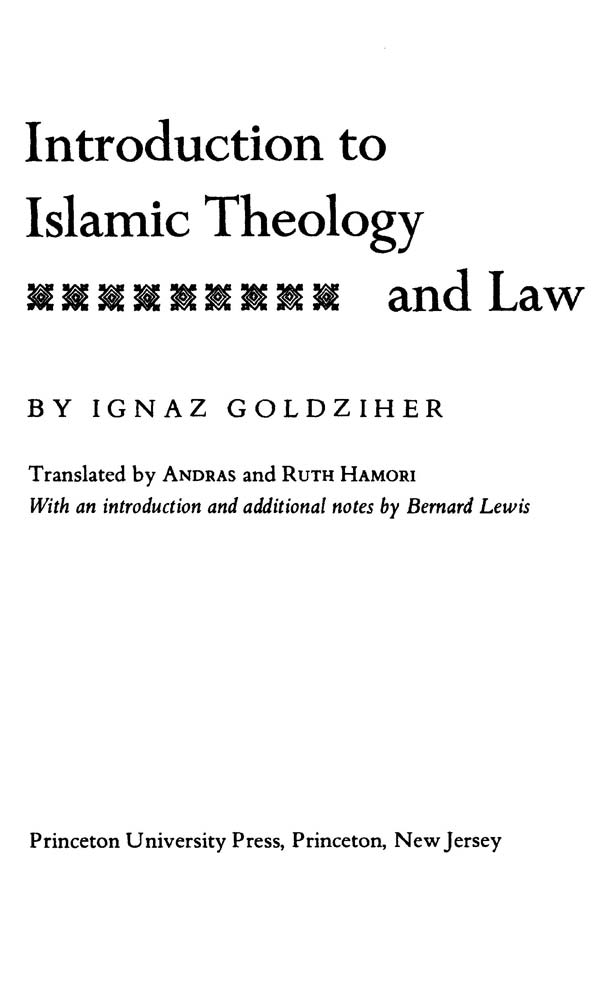
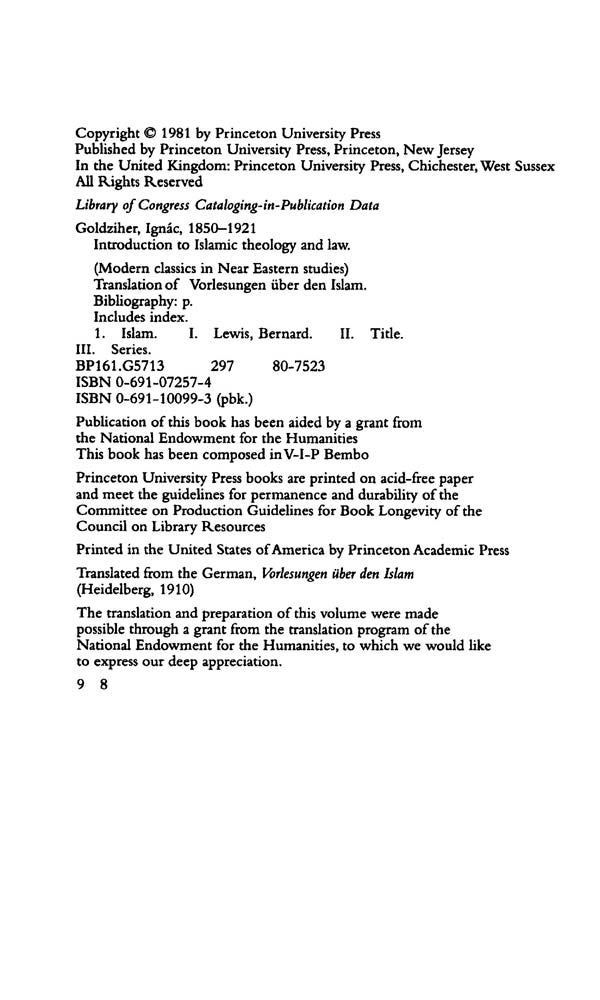
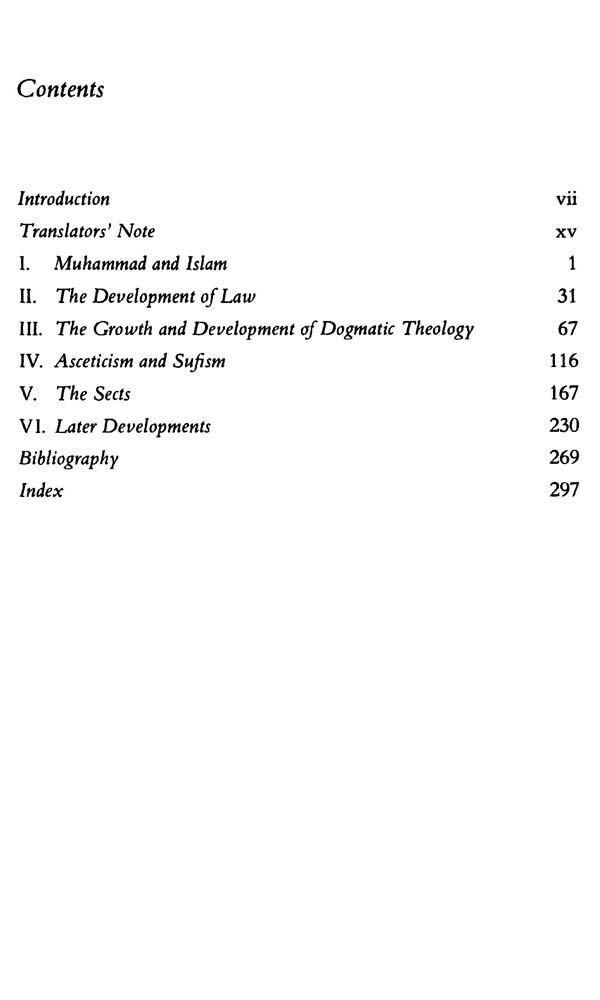
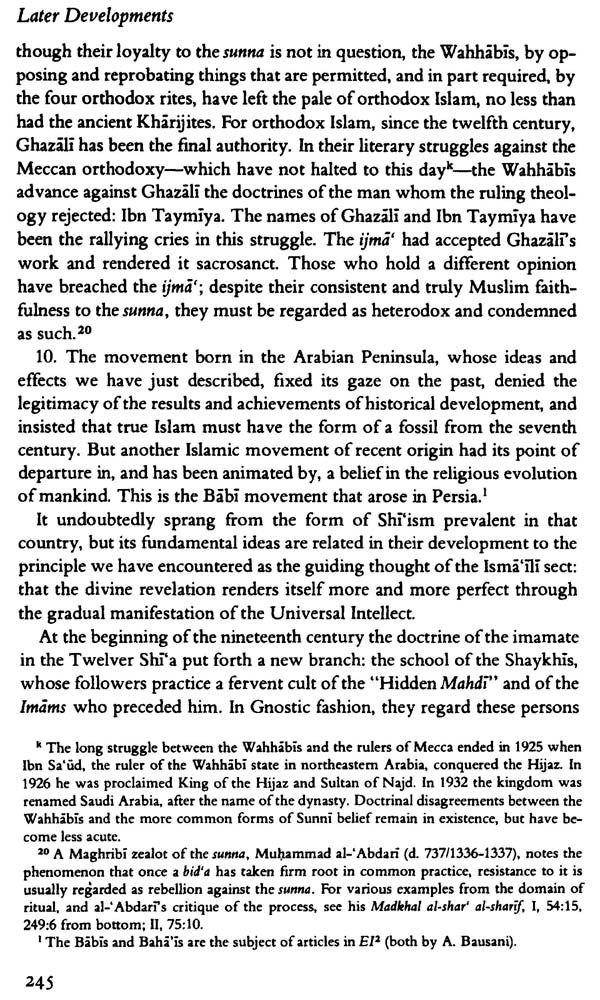

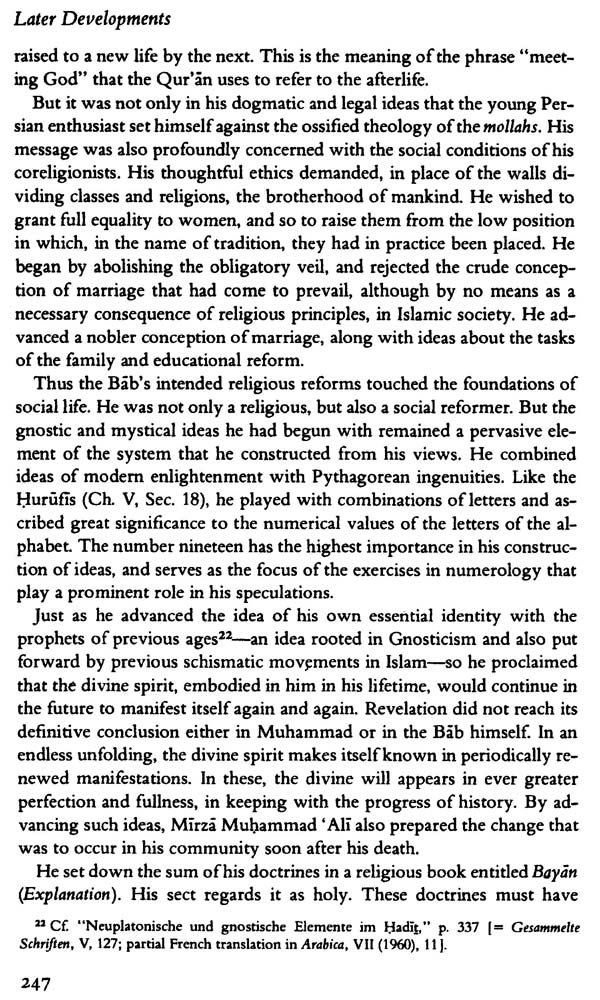

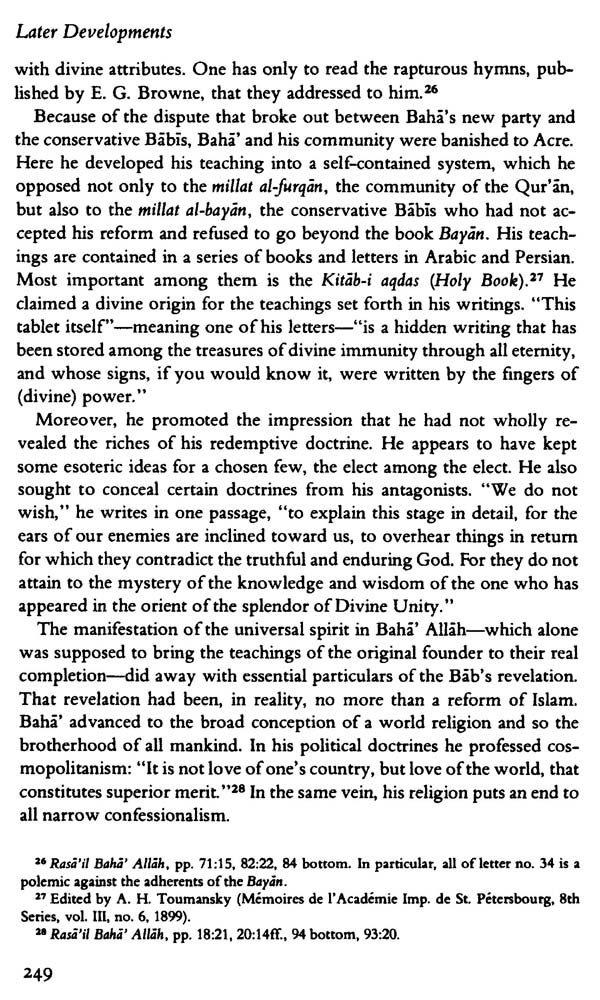
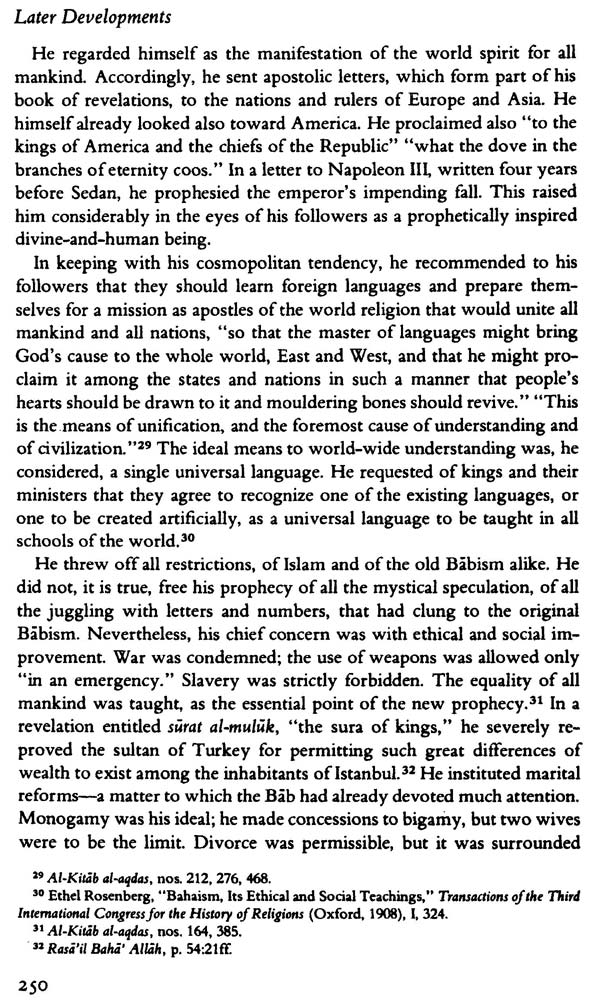

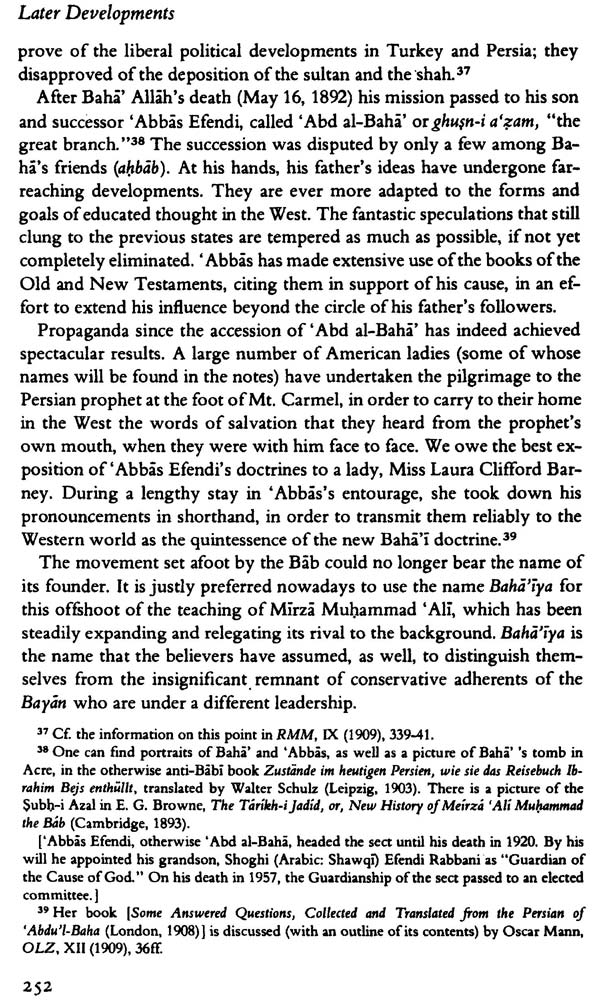
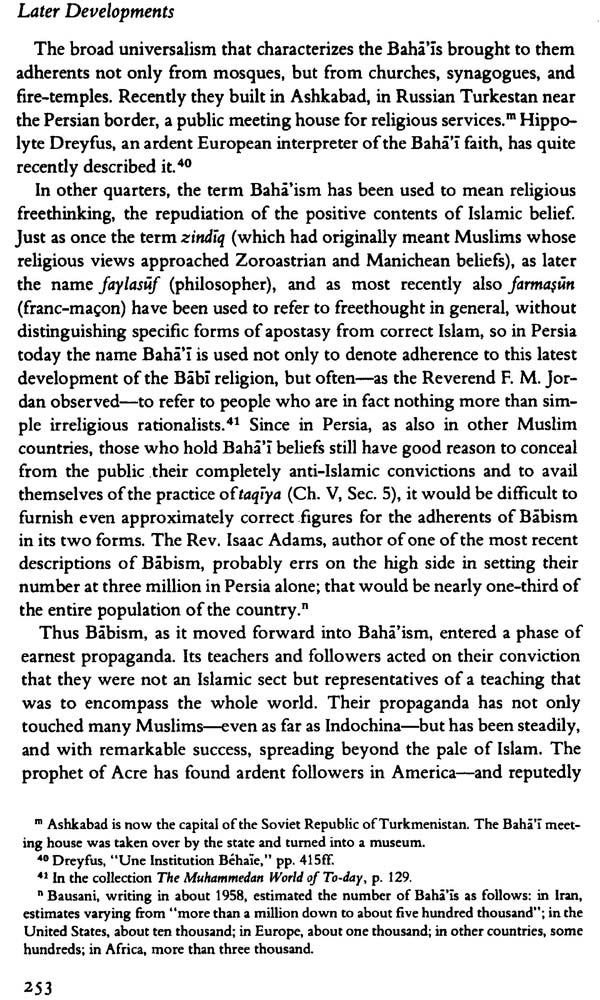
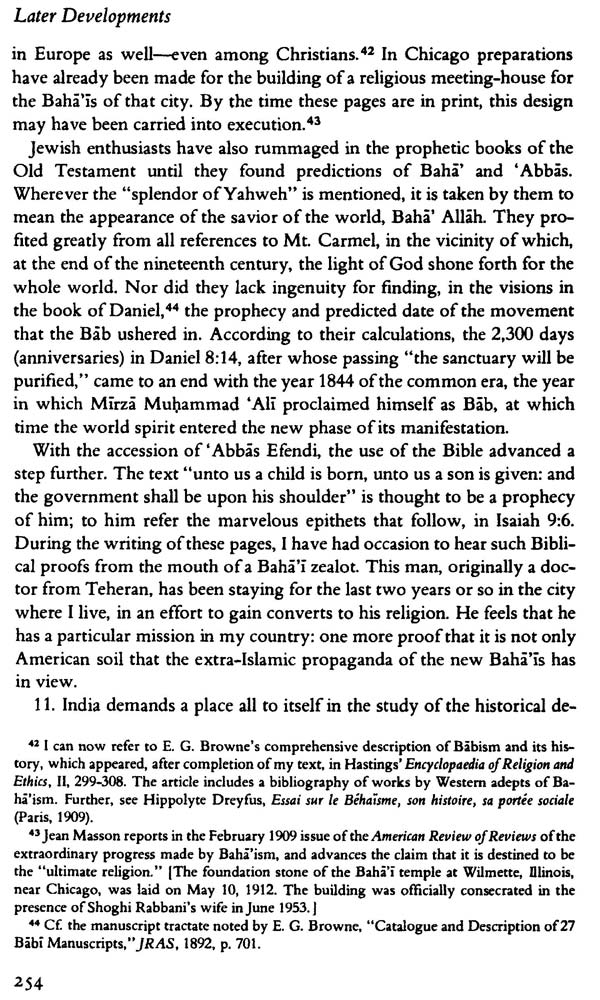
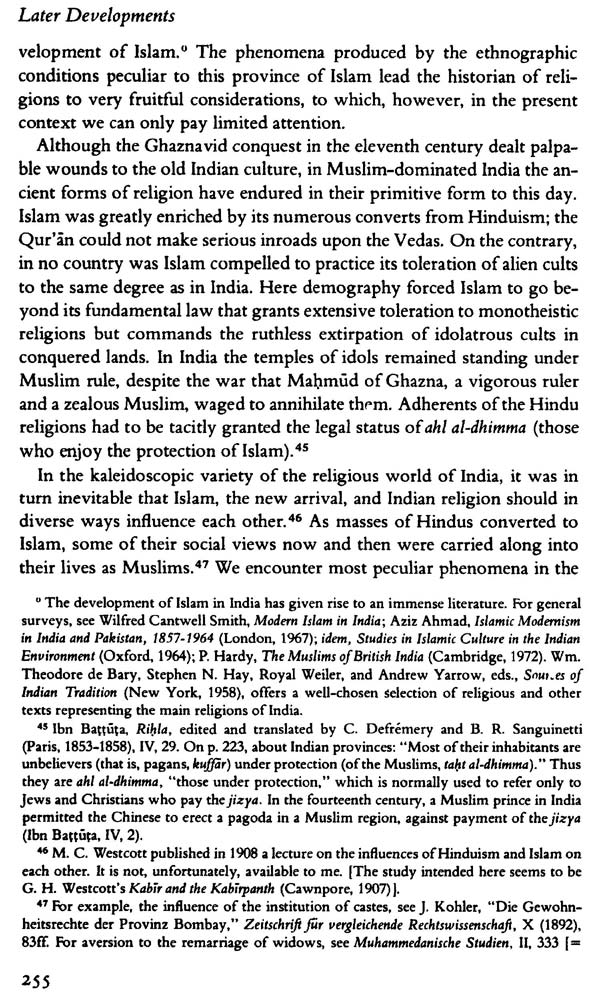
|
|